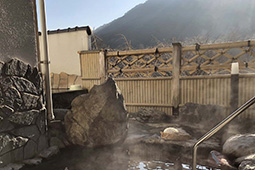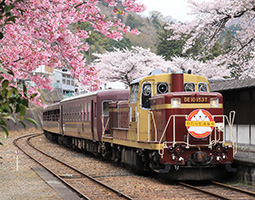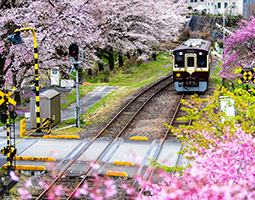February 2022
- English
- 日本語
The Station with a Spa: Mizunuma Station on the Watarase Keikoku Railway

The Kappa bath, named after the character of legend (see statue) said to live upstream from the spa center 
Mizunuma Station with Mizunuma Station Spa Center on the platform (right)

View over the tracks to the Mizunuma Station Spa Center entrance 
The open-air bath 
A Watarase Keikoku train, pulled by an old diesel locomotive, passes beneath weeping peach (left) and cherry trees (right) 
The peach and cherry blossoms attract many passengers to Watarase Keikoku sightseeing trains in the spring

Mizunuma Station, which is located in Kiryu City, Gunma Prefecture, approximately 100 km from central Tokyo, is unique for a train station in Japan in that it also has hot spring facilities. This station with a spa is cherished as a place of relaxation both by local residents and visitors.

Kiryu Station in Kiryu City, Gunma Prefecture, can be reached by train from Tokyo in as little as round 2 hours. From Kiryu Station, passengers can take the scenic Watarase Keikoku Railway toward Nikko in Tochigi Prefecture, an area famed for its hot springs, temples and shrines, in particular the national treasure Nikko Toshogu Shrine (see Highlighting Japan, September 2017).
Located about 40 minutes from Kiryu Station on the Watarase Keikoku Railway is Mizunuma Station, which is unique for a train station in Japan in that it also serves as a hot-spring center. A ride on the line is thus perfect for fans of local railways, who can not only enjoy the spectacular views from the train but also have a dip in the local hot spring waters without even having to leave the station.
Mizunuma Station Spa Center opened in December 1989 as a part of efforts to attract sightseers to the Watarase Keikoku Railway at a time when the number of passengers was in decline. The spa building is long and narrow, extending about 100 meters along the length of one of the station platforms. Spa users can watch the trains arriving and departing through the windows on the track side of the building, which is exciting even for those who would not normally consider themselves railway fans. Mizunuma Station also affords fine views over the valley of the Watarase River, and spa users can enjoy the beautiful seasonal landscapes through the bathhouse windows facing the valley. There are about 300 cherry trees of nine different types and more than 1,000 weeping peach trees on the “Sayado-Ohata Peach Blossom Road” near Mizunuma Station. When the trees start blossoming in early April, the banks of the Watarase River turn a delicate pink, a scene which can be enjoyed while soaking in the spa’s open-air bath.


The spa draws spring water from the Sarukawa hot spring on the slopes of nearby Mount Akagi via a 8-km-long pipe. Kamiyama Noboru of the Mizunuma Station Spa Center says, “The spring water is soft on the skin and is good for treating digestive disorders and arteriosclerosis. We also have saunas and indoor baths. The facilities are free for local residents aged 60 or over, so it’s used as a place of relaxation not just for tourists but also for local residents.”

The spa center also has a restaurant and a banquet room. Highlights on the menu include dishes that use local ingredients such as Maito salmon* and “mountain eel,” a local name for nutritious and sticky Japanese yam.
Watarase Keikoku Railway first operated as a private railway from 1912 called the Ashio Railway, transporting copper from the Ashio Copper Mine in Tochigi Prefecture, which was one of the biggest copper mines in Japan. It was later nationalized, but the decision was made to close the line when the mine was shut down in the early 1970s and the population living along the line decreased dramatically. However, thanks to a passionate citizens’ movement to keep the trains running, in 1989 the line started running again. Today, the Ashio Copper Mine Ruins are among a number of popular tourist destinations in the area, and are easily accessed from Mizunuma Station on the Watarase Keikoku Railway.

Mizunuma Station meanwhile is itself a popular local attraction, combining the appeal of the beautiful natural surroundings, relaxing hot spring water, and delicious local foods.
* Maito salmon, also known as Yashio trout, is a type of rainbow trout produced through selective breeding in Tochigi Prefecture.

